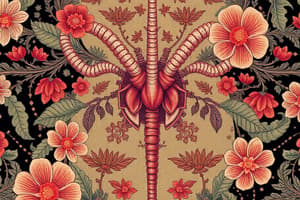Podcast
Questions and Answers
What hormone stimulates the release of growth hormone (GH)?
What hormone stimulates the release of growth hormone (GH)?
- Ghrelin (correct)
- Insulin
- Leptin
- Somatostatin
At what stage of life is the secretion of growth hormone typically at its peak?
At what stage of life is the secretion of growth hormone typically at its peak?
- Infancy
- Adulthood
- Puberty (correct)
- Elderly
Which of the following hormones negatively regulates the production of growth hormone?
Which of the following hormones negatively regulates the production of growth hormone?
- Growth hormone releasing hormone
- Ghrelin
- Insulin-like growth factor 1 (IGF1) (correct)
- Adrenocorticotropic hormone
What condition results from abnormal hyper-secretion of growth hormone in childhood?
What condition results from abnormal hyper-secretion of growth hormone in childhood?
What role does Insulin Growth Factor 1 (IGF-1) play in the action of growth hormone (GH)?
What role does Insulin Growth Factor 1 (IGF-1) play in the action of growth hormone (GH)?
What is the role of Janus Kinase 2 (JAK2) in the GH signaling pathway?
What is the role of Janus Kinase 2 (JAK2) in the GH signaling pathway?
In which condition is mecasermin particularly beneficial?
In which condition is mecasermin particularly beneficial?
What major action does growth hormone (GH) have related to body composition?
What major action does growth hormone (GH) have related to body composition?
Which process occurs when GH interacts with its receptors?
Which process occurs when GH interacts with its receptors?
What is the primary clinical effect of Tesamorelin?
What is the primary clinical effect of Tesamorelin?
What is a potential side effect of using mecasermin?
What is a potential side effect of using mecasermin?
What physiological role does growth hormone (GH) play during childhood?
What physiological role does growth hormone (GH) play during childhood?
What role does octreotide play in the treatment of GH-related conditions?
What role does octreotide play in the treatment of GH-related conditions?
What is pegvisomant used for?
What is pegvisomant used for?
What is the primary reason for administering GH releasing hormones?
What is the primary reason for administering GH releasing hormones?
Which scenario illustrates a condition of GH deficiency?
Which scenario illustrates a condition of GH deficiency?
Flashcards
Growth Hormone (GH) interaction with Insulin Growth Factor 1 (IGF-1)
Growth Hormone (GH) interaction with Insulin Growth Factor 1 (IGF-1)
GH stimulates the production of IGF-1, which then has effects similar to GH, influencing various tissues, including liver, bone, fat (adipocytes), and muscle.
Mecasermin
Mecasermin
Recombinant human IGF-1, used to treat GH deficiency where receptors don't work properly, even with high GH levels.
GH Deficiency
GH Deficiency
Lower-than-normal level of growth hormone.Can result in short stature in children.
Somatotropin
Somatotropin
Signup and view all the flashcards
Octreotide
Octreotide
Signup and view all the flashcards
Pegvisomant
Pegvisomant
Signup and view all the flashcards
Tesamorelin
Tesamorelin
Signup and view all the flashcards
Hypoglycemia (side effect of Mecasermin)
Hypoglycemia (side effect of Mecasermin)
Signup and view all the flashcards
GH production regulation
GH production regulation
Signup and view all the flashcards
GH secretion patterns
GH secretion patterns
Signup and view all the flashcards
GH action
GH action
Signup and view all the flashcards
GH receptor mechanism
GH receptor mechanism
Signup and view all the flashcards
Gigantism
Gigantism
Signup and view all the flashcards
Acromegaly
Acromegaly
Signup and view all the flashcards
IGF-1
IGF-1
Signup and view all the flashcards
Study Notes
Growth Hormone (GH) Production and Regulation
- GH and prolactin (PRL) are produced by specific cells in the anterior pituitary, regulated by the hypothalamus.
- GH release is stimulated by growth hormone-releasing hormone (GHRH) and Ghrelin, but inhibited by somatostatin (SST), GH itself, and insulin-like growth factor 1 (IGF-1).
- GH production is pulsatile, highest during sleep, stimulated by GHRH and Ghrelin, inhibited by SST, GH, and IGF-1.
- GH production is high in infancy, peaks during puberty, and decreases in adulthood.
- GH binds to cell-surface GH receptors (GHR) and activates them, stimulating the production of IGF-1, mainly by the liver.
- Elevated GH and IGF-1 levels induce negative feedback loops, inhibiting further GH secretion.
GH Actions and Effects
- GH promotes longitudinal bone growth, and increases glycolysis and body fat storage, supporting muscle mass, immune function, cardiovascular health, and nervous system well-being.
GH-Related Pathologies
- GH Hypersecretion: Leads to gigantism in childhood and acromegaly in adulthood, characterized by abnormal longitudinal bone growth.
- GH Deficiency/Signal Disruption: Causes short stature, or rare syndromes.
GH Receptors
- Similar to cytokine receptors, lacking intrinsic kinase activity.
- Rely on the recruitment of non-receptor tyrosine kinase JAK2 for activation.
GH Receptor Activation Pathway
- GH binding activates JAK2 within the receptor.
- JAK2 phosphorylates downstream targets, including STAT5.
- STAT5 dimerizes and enters the nucleus, modulating gene transcription.
- Genes involved in growth, metabolism, and sex dimorphism are affected.
GH-Related Treatment Approaches
- Replacement Therapy (Somatotropin): Uses GH analogues to treat GH deficiency.
- GH Receptor Bypass: In cases of receptor dysfunction, IGF-1 replacement (mecasermin) is used, aiming to mimic the effects of GH.
- GH Release Stimulation (Tesamorelin): Synthetic GHRH analogue mimicking hypothalamic function, reduces visceral fat accumulation.
Studying That Suits You
Use AI to generate personalized quizzes and flashcards to suit your learning preferences.




